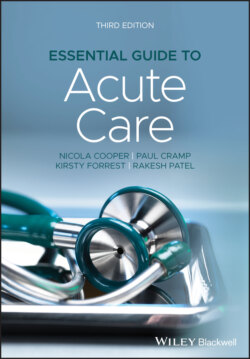Читать книгу Essential Guide to Acute Care - Nicola Cooper - Страница 16
What is Resuscitation?
ОглавлениеWhen we talk about ‘resuscitation’ we often think of cardio‐pulmonary resuscitation (CPR). CPR is a significant part of healthcare training. International organisations govern resuscitation protocols. Yet, survival to discharge after in‐hospital CPR is poor, around 50% if the rhythm is shockable and 10–14% if the rhythm is non‐shockable.1 Public perception of CPR is often informed by television which has far better outcomes than in reality.2
A great deal of attention and training is focussed on saving life after cardiac arrest. But the majority of in‐hospital cardiac arrests are predictable and preventable. Until the last few decades, hardly any attention was focussed on detecting commonplace reversible physiological deterioration and in preventing cardiac arrest in the first place. Now, we have early warning scores and medical emergency teams – but there still remain problems with the early recognition and management of sick patients in hospital.
In a study published in 1990, 84% of patients had documented observations of clinical deterioration or new complaints within 8 hours of cardio‐pulmonary arrest and 70% had either deterioration in respiratory or mental function observed during this time.3 While there did not appear to be any single reproducible warning signs, the average respiratory rate of the patients prior to arrest was 30/min. The investigators observed that the predominantly respiratory and metabolic derangements which preceded cardiac arrest (hypoxaemia, hypotension, and acidosis) were not rapidly fatal and that efforts to predict and prevent arrest would therefore be beneficial. Only 8% patients survived to discharge after CPR. A subsequent similar study observed that documented physiological deterioration occurred within 6 hours in 66% of patients with cardiac arrest, but effective action was often not taken.4
Researchers have commented that there appears to be a failure of systems to recognise and effectively intervene when patients in hospital deteriorate. A study by McQuillan et al. looked at 100 consecutive emergency ICU admissions.5 Two external assessors found that only 20 cases were well managed beforehand. The majority (54) received suboptimal care prior to admission to the ICU and there was disagreement over the remaining 26 cases. The patients were of a similar case‐mix and APACHE (acute physiological and chronic health evaluation) scores. In the suboptimal group, ICU admission was considered late in 69% cases and avoidable in up to 41%. The main causes of suboptimal care were considered to be failure of organisation, lack of knowledge, failure to appreciate the clinical urgency, lack of supervision, and failure to seek advice. Suboptimal care (failure to adequately manage the airway, oxygen therapy, breathing, and circulation) was equally likely on a surgical or medical ward and contributed to the subsequent mortality of one‐third of patients. The authors wrote: ‘This…suggests a fundamental problem of failure to appreciate that airway, breathing and circulation are the prerequisites of life and that their dysfunction are the common denominators of death’. Another study of adult general ward patients admitted to the ICU or dying unexpectedly found that both ICU and hospital mortality was significantly increased in patients who had received suboptimal care beforehand (52% vs 35% and 65% vs 42%, respectively).6 Similar findings have been reported in other studies.
Although things may have improved, these problems have not gone away. The UK National Confidential Enquiry into Patient Outcome and Death (NCEPOD) published a report in 2018: ‘Themes and recommendations common to all hospital specialties’.7 The report stated that:
Deficiencies in the recognition of ill patients have been identified for many years and the care of the acutely ill hospitalised patient presents ongoing problems for healthcare services. Deficiencies are often related to poor management of simple aspects of acute care – those involving the patient’s airway, breathing and circulation, oxygen therapy, fluid balance and monitoring. Other contributory factors highlighted in many NCEPOD reports include organisational failures, such as a lack of knowledge, failure to appreciate the clinical urgency of a situation, a lack of supervision, failure to seek advice, delayed response and poor communication.
A number of studies have showed that simple physiological observations can identify high‐risk hospital in‐patients8,9 and implementing a system whereby junior staff are obliged to call for help when there are seriously abnormal vital signs improves outcomes for patients and utilisation of intensive care resources.10,11
Resuscitation is therefore not only about CPR. It is about recognising and effectively treating patients in reversible physiological decline. This is an area of medicine that is often neglected outside critical care areas in terms of training, organisation, and resources.
